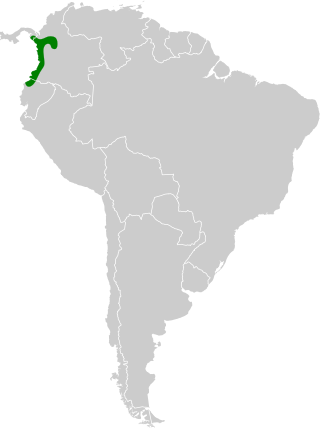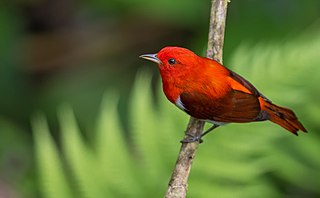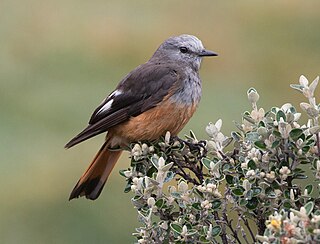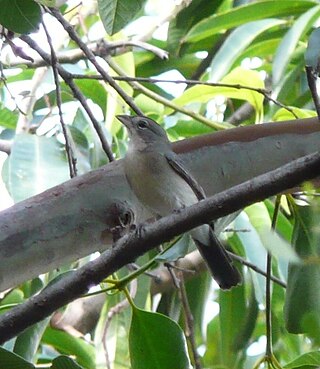
The olivaceous siskin is a species of finch in the family Fringillidae. It is found in Bolivia, Ecuador, and Peru, where its natural habitats are subtropical or tropical moist montane forests and heavily degraded former forest.

Carmiol's tanager is a species of bird in the cardinal family Cardinalidae that is found in Central America from Nicaragua southwards to northwest Colombia. Its natural habitats are subtropical or tropical moist lowland forests and heavily degraded former forest. It was formerly considered as conspecific with the yellow-lored tanager.

The lemon-spectacled tanager is a species of bird in the family Cardinalidae. It is found in Colombia, Ecuador, and Panama where its natural habitats are subtropical or tropical moist lowland forest, subtropical or tropical moist montane forest, and heavily degraded former forest.

The scarlet-and-white tanager is a species of bird in the family Thraupidae. It is found in Colombia and northern Ecuador. Its natural habitats are subtropical or tropical moist lowland forests and heavily degraded former forest. The male is highly distinctive and has bright scarlet upperparts, darker red wings and undertail coverts, and white underparts with a scarlet median stripe running down the throat and belly. Females are patterned like the males, but are olive-brown instead of scarlet.

The red-rumped bush tyrant is a species of bird in the family Tyrannidae. It is found in Bolivia, Colombia, Ecuador, and Peru. Its natural habitats are subtropical or tropical moist montane forests and subtropical or tropical high-altitude grassland.

The smoke-colored pewee is a species of bird in the family Tyrannidae. The species is characterized by a uniform dusky-grey plumage.

The red pileated finch, also known as the red-crested finch, is a species of bird in the family Thraupidae. It is found in Argentina, Bolivia, Brazil, Ecuador, French Guiana, Guyana, Paraguay, Peru, on the eastern side of the Andes. Its natural habitats are subtropical or tropical dry forests, subtropical or tropical moist lowland forests, subtropical or tropical dry shrubland, and heavily degraded former forest. This is a common species, and the International Union for Conservation of Nature has rated its conservation status as "least concern".

The grey pileated finch, also known as the pileated finch, is a species of bird in the family Thraupidae, where it has recently been moved to from the Emberizidae. It is found in Brazil, Colombia, French Guiana, and Venezuela in subtropical or tropical dry forests, subtropical or tropical moist lowland forests, subtropical or tropical dry shrubland, and heavily degraded former forest.

The black-billed peppershrike is a species of bird in the family Vireonidae. It is found in the Andes of Colombia and northern Ecuador. It inhabits subtropical or tropical moist montane forests and heavily degraded former forest.

The white-sided flowerpiercer is a fairly common and widespread species of Flowerpiercer. Flowerpiercers are a genus of birds within the Tanager family Thraupidae, with specially adapted bills that enable them to pierce the sides of flower blossoms to access the nectar. The white-sided flowerpiercer is found in Colombia, Ecuador, Peru, and Venezuela. Its natural habitats are subtropical or tropical moist montane forests and heavily degraded former forest.

The white-winged shrike-tanager is a species of bird in the family Thraupidae. It is found in Bolivia, Brazil, and Peru in subtropical or tropical moist lowland forests. Two subspecies are recognised, L. v. versicolor from eastern Peru, western Brazil and northern Bolivia, and L. v. parvus from eastern and central Brazil and northeastern Bolivia.

The rufous-tailed stipplethroat or rufous-tailed antwren is a species of insectivorous bird in the antbird family Thamnophilidae. It was formerly placed in the genus Myrmotherula. It is found in Brazil, Colombia, Ecuador, and Peru. Its natural habitat is subtropical or tropical moist lowland forests.

The stripe-chested antwren is a species of bird in the family Thamnophilidae found in Bolivia, Ecuador, and Peru and southwestern Colombia. Its natural habitats are subtropical or tropical moist lowland forests, subtropical or tropical moist montane forests, and heavily degraded former forest.

The fiery-throated fruiteater is a species of bird in the family Cotingidae. It is found in Colombia, Ecuador, and Peru where its natural habitats are subtropical or tropical moist lowland forests and subtropical or tropical moist montane forests. It is becoming rare due to habitat destruction of its rainforest habitat.

The black-chested fruiteater is a species of bird in the family Cotingidae found in Colombia, Ecuador, and Peru, mostly on the eastern side of the Andes. Its natural habitat is subtropical and tropical moist montane forests and the IUCN lists its status as being of "least concern".

The rosy thrush-tanager or rose-breasted thrush-tanager is a species of bird in the currently monotypic genus Rhodinocichla. It was formerly assigned to the family Thraupidae and more recently viewed as being of uncertain placement; a 2015 molecular study places it closest to the Calcariidae. Found in Colombia, Costa Rica, Mexico, Panama, and Venezuela, its natural habitats are subtropical or tropical dry forests, subtropical or tropical moist lowland forests, and heavily degraded former forest.

The flame-crested tanager is a species of bird in the family Thraupidae. It is found in Bolivia, Brazil, Colombia, Ecuador, French Guiana, Guyana, Peru, Suriname, and Venezuela. Its natural habitats are subtropical or tropical moist lowland forests and subtropical or tropical dry shrubland. Ten subspecies are currently recognized.

The black-capped tanager is one of the many species of Neotropical bird in the family Thraupidae. It lives in mountains of Ecuador, Colombia and Venezuela year-round. This bird can often be found in open landscapes, alone or in pairs, hiding under branches of trees and bushes. Its natural habitats are subtropical or tropical moist montane forests and heavily degraded former forest.

The flame-faced tanager is a species of bird in the tanager family Thraupidae. It is endemic to South America and is found in the eastern Andes of Colombia, Ecuador, Peru and Venezuela. Its natural habitat is subtropical or tropical moist montane forests. It is a distinctive-looking species with black and opalescent green upperparts, opalescent green and buff underparts, and a deep red and yellow face. The subspecies lunigera lacks the deep red on the face, which is replaced with orangish-red.

The moustached brushfinch is a species of bird in the family Passerellidae.






















